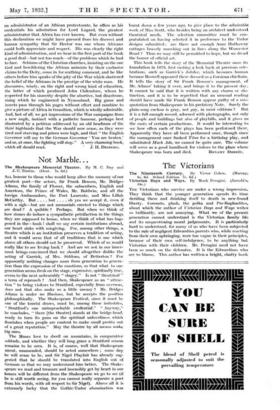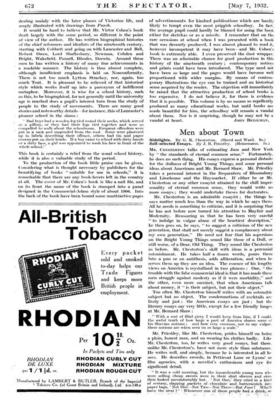The Victorians
TIIE Victorians who survive are under a wrong impression. They think that the younger generation spends its time deriding them and drinking itself to death in new-found liberty. Coronets, plush, the polka and Pre-Raphaelites, about which the author of Victorian Days and tWays writes so brilliantly, are not annoying. What we of the present generation cannot understand is the Victorian family life and its unquestioning moral judgements. It is particularly hard to understand, for many of us who have been subjected to the rule of negligent Edwardian parents who, while reacting from their own upbringing, were too vague in their principles, because of their own self-indulgence, to be anything but Victorian with their children. Mr. Perugini need not have been so much on the defensive. It is the Edwardians who are to blame. This author has written a bright, chatty book
dealing mainly with the later phases of Victorian life, and amply illustrated with drawings from Punch.
It would be hard to believe that Mr. Victor Cohen's book dealt largely with the same period, so different is the point of view of the author. He has written biographical histories of the chief reformers and idealists of the nineteenth century, starting with Cobbett and going on with Lancaster and Bell, Robert Owen, Lord Shaftesbury, Newman, Cobden and Bright, Wakefield, Parnell, Rhodes, Darwin. Around these men he has written a history of many fine achievements in " a readable manner. The history is thus almost complete, although insufficient emphasis is laid on Nonconforntity. There is not too much Lytton Strachey, nor, again, too much Tout. It is pleasant to be relieved of that historical style which works itself up into a paroxysm of indifferent metaphor. Moreover, it is wise for a school history, such as this, to be biographical, for not generally until the university age is reached does a pupil's interest turn from the study of people to the study of movements. There are many good stories and noteworthy details—for instance, this of Lancaster's . pioneer school in the slums : . . " Bad boys had a wooden leg tied round their necks, which served as a pillory, or they had their legs tied together and were so compelled to walk about the schoolroom. Frequent offenders were put in a sack and suspended from the roof. Some were plastered up in labels describing their offence, others had tin and paper crowns put on their heads. If a boy came to school with dirty hands or a dirty face, a girl was appointed to wash his face in front of the whole school."
This book is certainly a relief from the usual school history, while it is also a valuable study of the period.
To the production of the book little praise can be given. Considering what is thought necessary by publishers for the beautifying of books " suitable for use in schools," it is remarkable that there are any book-lovers left in the country at all. The cover of Mr: Cohen's book is like a nail file, and on its front the name of the book is stamped into a panel designed in the. Commercial-Adam style of about 1996. Into the back of the book have been bound some unattractive pages of advertisements for kindred publications which are hardly likely to tempt even the most priggish schoolboy. In fact, the average pupil could hardly be blamed for using the book either for sketchts or as a missile. I remember that on the rare occasions at school when I was presented with a book that was decently produced, I was almost pleased to read it, however incompetent it may have been—and Mr. Cohen's book is extremely able. I even preserved the dust wrapper. There was an admirable chance for good production in this history of the nineteenth century ; contemporary notices and prints could have been introduced. The type need not have been so large and the pages would have become well proportioned with wider margins. By means of contem- porary illustrations the eye can be trained and an historiml sense acquired by the reader. The objection will immediately be raised that the attractive production of school books is too expensive. I do not believe it, for there is evidence that it is possible. This volume is by no means so repellently produced as many educational works, but until books are made beautiful for him, the schoolboy will remain a vandal about them. Nor is it surprising, though he may not be a







































 Previous page
Previous page